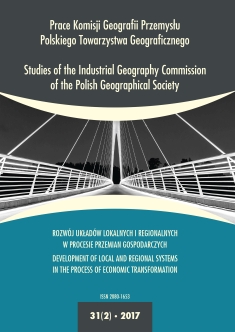Land Use Changes with Particular Focus on Industrial Lands in Polish Major Cities and Their Surroundings in the Years 2005, 2009 to 2014
DOI:
https://doi.org/10.24917/20801653.302.8Keywords:
deindustrialisation, functional areas, industrial areas, land use, metropolitan areas, suburbanisationAbstract
This article has been placed in widely debated in scientific and political communities issues of suburbanization, changes of functions and in the spatial structure of cities and their surrounding outer areas. Discussion and research concerning this phenomenon focus mainly on social, demographic and economic issues. Dynamics of mentioned issues at the interface between the core city and the outer suburbs and exurbs are raised in the publications. Areas (zones) outside the city are delimited in different ways by different institutions. In Poland there is observed a noticeable lack of consensus in scientific as well as political dimension on criteria of such delimitations. This areas are defined like an urban functional areas, metropolitan region of the city, suburbs, more traditionally and holistic - agglomeration area. Particularly scientifically interesting among a number of issues concerning the relationship between central area (core city) and the area outside city borders, especially the process of moving outside central urban areas or development industrial functions in exurbs areas. This article aims to analyze and answer of the following question. What are relationships between core-city- and exurbs-area-concerned directions, scale and dynamics changes in land use: industrial land, housing, communications, other built-up. In a narrower sense this research is an attempt to confirm the observation of deindustrialization of core cities, measured by industrial land use. In order to achieve the goals, datasets from GUGiK (Polish Main Office for Geodesy and Cartography) for the years 2009 and 2014, data collected for land and municipal counties (poviats - NUTS level 4) have been used. Data are related to surface and land use in the administrative unit according to the official classification. In addition to the core cities more thorough analyses since 2005 (according to data availability) were made. To complete the full picture of presented phenomena, data on industrial productivity by counties were used. The exurbs area has been delimited by selecting counties surrounding the core cities - with reference delimitation of metropolitan regions based on NUTS 3 used by Eurostat and Urban Functional Areas in Poland set out in the KPZK (National Spatial Development Concept).
Downloads
Metrics
References
Bachmann, M. (2003). Enquiry of Enterprises, Report of the EU research project COMET. Berlin.
Chojnicki, Z. (1988). Koncepcja terytorialnego systemu społecznego. Przegląd Geograficzny, 60(4), 502–503.
Domański, R. (2004). Geografia społeczno-ekonomiczna. Ujęcie dynamiczne. Warszawa: PWN.
Domański, R. (2007). Gospodarka przestrzenna. Podstawy teoretyczne. Warszawa: PWN.
Forman, R.T. (2008). Urban Regions, Ecology and Planning Beyond the City. Cambridge, New York, Melbourne, Madrid, Cape Town, Singapore, São Paulo: Cambridge University Press.
Georgescu-Roegen, N. (1972). The entropy law and the economic process. Cambridge.
Kafka, K. (2012). Obszary metropolitalne w krajowych i regionalnych dokumentach planistycznych. W: Z. Ziobrowski, W. Jarczewski, K. Kafka. Modele zarządzania gospodarką przestrzenną w obszarach metropolitalnych i aglomeracjach. Kraków: Instytut Rozwoju Miast, 74–86.
Mariotti, I. (2005). Firm relocation and regional policy. A focus on Italy, the Netherlands and The United Kingdom. Utrecht/Groningen: Royal Dutch Geographical Society, Department of Spatial Sciences University of Groningen.
Moriarty, B.M. (1983). Hierarchies of Cities and the Spatial Filtering of Industrial Development. Papers of the Regional Science Association, 53, 59–82.
Park, R.E., Burgess, E.W., McKenzie, R.D. (1925). The City. Chicago and London: The University of Chicago Press.
Rowthorn, R., Ramaswamy, R. (1997) (2016, 18 stycznia). Deindustrialization: Causes and Implications. International Monetary Fund. Pozyskano z https://www.imf.org/external/ pubs/ft/wp/wp9742.pdf
Rozporządzenie Ministra Rozwoju Regionalnego i Budownictwa z dnia 29 marca 2001 r. w sprawie ewidencji gruntów i budynków (Dz.U. z 2001 r. nr 38 poz. 454).
Rozporządzenie Rady Ministrów z dnia 9 listopada 2012 r. w sprawie programu badań statystycznych statystyki publicznej na rok 2013 (Dz.U. z 2012 r. poz. 1391).
Staszewska, S., Marcinowicz, D. (2006). Struktura funkcjonalno-przestrzenna wybranych terenów przemysłowych Poznania. Prace Komisji Geografii Przemysłu Polskiego Towarzystwa Geograficznego, 9, 74–82.
Sztaba, J. (2013). Rewitalizacja szansą dla regionów poprzemysłowych. Studia i Materiały Wydziału Zarządzania i Administracji Uniwersytetu Jana Kochanowskiego w Kielcach, 109–119.
Śleszyński, P. (2013). Delimitacja miejskich obszarów funkcjonalnych stolic województw. Przegląd Geograficzny, 85(2), 173–197.
Ustawa z dnia 17 maja 1989 r. Prawo geodezyjne i kartograficzne (Dz.U. z 1989 r. nr 30 poz. 163).
Węcławowicz, G., Łotocka, M., Baucz, A. (2010). Rozwój miast w Polsce. Raport wprowadzający Ministerstwa Rozwoju Regionalnego. Warszawa: Ministerstwo Rozwoju Regionalnego.
Wierzchowski, M. (2009). Zagospodarowanie gruntów w Polsce stan w dniu 1.01.2009 roku. Kraków: Instytut Rozwoju Miast.
Wyłączanie gruntów z produkcji rolniczej i jego skutki dla ewidencji podatkowej w gminach w latach 2007–2012 (2012). Warszawa: Najwyższa Izba Kontroli.
Zagajewski, B. (2013). Zastosowanie teledetekcji do oceny stanu zagospodarowania przestrzennego w Polsce. Biuletyn Komitetu Przestrzennego Zagospodarowania Kraju, 252, 13–29.
Downloads
Published
How to Cite
Issue
Section
License
Articles are published under the terms of the Creative Commons License (CC BY-ND 4.0; Attribution– NoDerivs).

